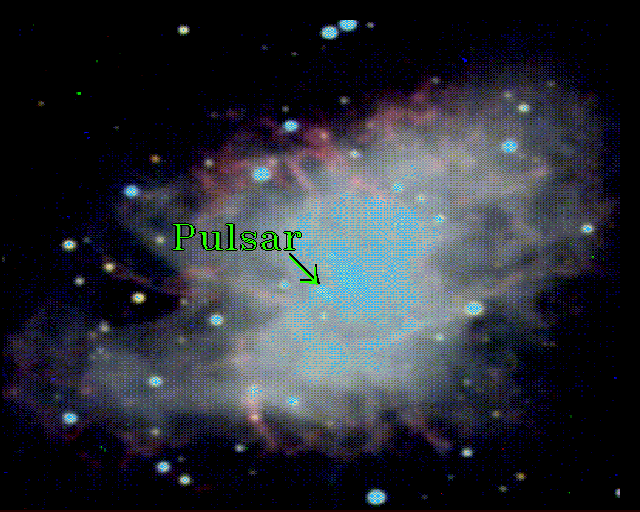neufer wrote:icehouse wrote:Where's the black hole that accompanied the supernova?
Supposedly it is hidden in the blackground.
I couldn't help giggling at this, but you deserve a more serious answer, icehouse.
The truth is that, while astronomers believe that black holes are created in supernova explosions, not a single black hole has been found that can be directly linked to a detectable supernova remnant.
But there
are supernova remnants that definitely contain the extremely compact remnant of the star that once exploded. The most famous of these remnants is the Crab Nebula:

The Crab Nebula is believed to be the remnant of the supernova that was detected by Chinese and Arab astronomers in 1054 AD.
The Crab Nebula contains a pulsar, a rotating neutron star, which is an extremely compact "burnt-out" stellar core that weighs many times more than the Sun, even though it is compressed to a size that is far smaller than the Earth. The Crab Nebula pulsar is located pretty much in the middle of the Crab Nebula:

The Crab Nebula pulsar.
Another supernova remnant that contains a pulsar is the Vela supernova remnant. See APOD, September 10, 2010:
http://apod.nasa.gov/apod/ap100910.html
Also see this thread, where you can find posts describing the position of the Vela pulsar inside the Vela supernova remnant:
http://asterisk.apod.com/vie ... =9&t=21046
But not all supernova remnants seem to contain any sort of compact remnant of the star that actually exploded. Probably the best-observed supernova explosion ever is SN 1987A in the Large Magellanic Cloud. Astronomers managed to identify the star that had exploded:
The supernova and the star that exploded, before it exploded.
Astronomers know enough about the star that exploded to say that it should leave either a pulsar or a black hole behind. But despite extensive searches with the best telescopes, no compact remnant has been found in the glowing gas cloud that has been left behind:

No compact remnant of any kind has been found here.
On the other hand, it is known that neutron stars and even pulsars can be found where they can not be associated with supernova remnants. The gaseous shells may have disappeared, leaving the neutron star of pulsar seemingly "naked", or the neutron star or pulsar may have been given a "kick" by the supernova explosion itself if that explosion was asymmetric. That way, the pulsar or neutron star may simply have been "flung away" from the glowing gaseous shells.
Geminga is a famous neutron star that isn't clearly associated with any known supernova remnant. You can read about Geminga here:
http://en.wikipedia.org/wiki/Geminga
I would like to quote a bit from that Wikipedia article:
Thus, it is supposed that Geminga is a sort of neutron star: the decaying core of a massive star that exploded as a supernova about 300,000 years ago.
...
The proper motion of Geminga is 178.2 mas/year which corresponds to a projected velocity of 205 kilometers per second.[1] This is very fast for a star, comparable to Barnard's star.
So Geminga is a lonely neutron star that is speeding through space. Many astronomers speculate that the neutron star (or possible black hole) that ought to have been left behind by Supernova 1987A may simply have been "kicked out of the system", flung away from the glowing gaseous remnants, by the explosion itself.
As for speeding neutron stars, please click on the link below to see the speeding binary Vela X-1. Vela X-1 contains one massive blue supergiant and one compact stellar core, the remnant of a supernova explosion. This pair is speeding through space so fast that they create a bow shock in front of them:
http://www.eso.org/public/archives/imag ... o9702a.jpg
So while it is known that supernovae can leave behind neutron stars, and while it is known that neutron stars can speed away from the glowing gaseous remnants that mark the spot of the original supernova, not a single black hole has been definitely linked to an existing glowing gaseous supernova remnant. However, a few good stellar mass black hole candidates exist in our galaxy. The best one may be located in the binary star Cygnus X-1. This is a part of what Wikipedia writes about Cygnus X-1:
Cygnus X-1 (abbreviated Cyg X-1)[11] is a well known galactic X-ray source[12] in the constellation Cygnus. It was discovered in 1964 during a rocket flight and is one of the strongest X-ray sources seen from Earth, producing a peak X-ray flux density of 2.3 × 10−23 Wm−2Hz−1 (2.3 × 103 Jansky).[13][14] Cygnus X-1 was the first X-ray source widely accepted to be a black hole candidate and it remains among the most studied astronomical objects in its class. It is now estimated to have a mass about 8.7 times the mass of the Sun[6] and has been shown to be too compact to be any known kind of normal star or other likely object besides a black hole. If so, the radius of its event horizon is probably about 26 km.[15]
The probable black hole in Cygnus X-1 was most likely created when the massive progenitor star exploded as a supernova.
The thing to remember is that not all supernovae explosions leave black holes behind. Far from it. Also remember that there is a whole other class of supernovae, the Type 1a supernovae that are created when massive white dwarfs get "overloaded" by an additional helping of mass. These very common supernovae never leave behind either neutron stars or black holes.
Ann





